Thermodynamic Processes and Indicator Diagrams
Thermodynamic Processes and Indicator Diagrams: Overview
This Topic covers sub-topics such as Work Done in Adiabatic Process, Reversible and Irreversible Processes, Quasi-static Process, Isotherm, Work Done in Isothermal Process, Polytropic Process, Cyclic Process and, Adiabatic Process Examples
Important Questions on Thermodynamic Processes and Indicator Diagrams
The internal energy of a gas during isothermal expansion
The internal energy of a prefect gas does not change during
The thermodynamic process in which the pressure of the system remains contant is called
Two identical samples of gas are allowed to expand isothermally and adiabatically. The amount of work done id then
Compressed air coming out of punctured football becomes cooler because of
One mole of an ideal monoatomic gas undergoes the following four reversible processes:
Step 1 It is first compressed adiabatically from volume to .
Step 2 Then expanded isothermally at temperature to volume .
Step 3 Then expanded adiabatically to volume
Step 4 Then compressed isothermally at temperature to volume .
Then, is
A long cylindrical pipe of radius is closed at its upper end and has an airtight piston of negligible mass as shown. When a mass is attached to the other end of the piston, it moves down. If the air in the enclosure is cooled from temperature to the piston moves back to its original position. Then is close to (Assuming air to be an ideal gas, atmospheric pressure is )
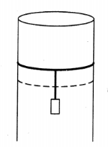
Which of the following statements about the diagram of an ideal gas of fixed number of particles is incorrect?
In a non cyclic process, which of the following statement is correct?
Quasi-static process is :
One mole of an ideal gas is taken around the complete cycle as shown in the PV-diagram. Considering the universal gas constant R, the work done by the gas in one complete cycle is:
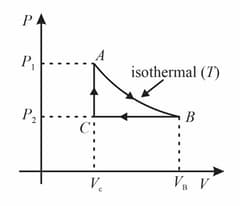
From the given options, using which variables for X and Y -axis we can make an isotherm graph?
If an ideal diatomic gas follows the process as shown in graph, where is temperature in and is volume in , then molar heat capacity for this process will be [in terms of gas constant ],
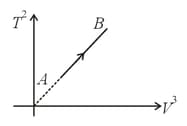
For a reversible process, necessary condition is
A rigid diatomic ideal gas undergoes an adiabatic process at room temperature. The relation between temperature and volume for this process is constant, then is:
A cycle tyre bursts suddenly. What is the type of this process?
An ideal gas undergoes four different processes from the same initial state Four processes are adiabatic, isothermal, isobaric and isochoric. Out of and which one is adiabatic.
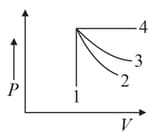
The relation between the internal energy and adiabatic constant is,
Two identical cylinders and with frictionless pistons contain the same ideal gas at the same temperature and the same volume . The mass of the gas in is and that in is . The gas in each cylinder is now allowed to expand isothermally to the same final volume . The change in the pressure in and are found to be and respectively. Then
P-V plots for two gases during adiabatic processes are shown in the figure. Plots and should correspond respectively to:
